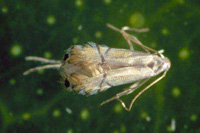Development of the Mating Disruption Technique for Control of Citrus Leafminer
Project description and objectives:
The citrus leafminer (CLM), Phyllocnistis citrella, is an important pest in Florida citrus. Mated female CLM lay eggs on the underside of host leaves. Emerging larvae
enter leaves to begin feeding. Larvae bore serpentine mines within young  leaves or shoots, resulting in leaf curling. Heavy infestations can result in serious damage.
The feeding larval stage is protected within the mines of infested foliage. Feeding damage caused by CLM larvae within the leaf mines predisposes trees to infection
by citrus canker. In groves of bearing trees, managing leafminer during the summer with chemical sprays is not sustainable because of the prolonged and sporadic
flush patterns influenced by summer rain events. Insect sex-attractant pheromones are chemical signals emitted into flowing air by female insects that guide males to
the source of the resultant aerial plume for mating. CLM females attract males from distances of 40 yards or more for mating. Mating disruption is the practice of
deploying synthetic pheromones into crop atmospheres to confuse males and prevent them from finding females. The end-result is reduction in fertilized eggs and
resultant damaging larvae because females failed to mate. Mating disruption is non-toxic to beneficial organisms, highly species specific and an essential component
of IPM programs for major moth pests worldwide. Preliminary investigations in 2007 have proven that mating disruption should be a highly effective control tactic
against CLM. The purpose of this project is to develop and evaluate a biodegradable wax-based dispensing formulation for CLM pheromone that is inexpensive to
produce and could eventually be machine applied.
leaves or shoots, resulting in leaf curling. Heavy infestations can result in serious damage.
The feeding larval stage is protected within the mines of infested foliage. Feeding damage caused by CLM larvae within the leaf mines predisposes trees to infection
by citrus canker. In groves of bearing trees, managing leafminer during the summer with chemical sprays is not sustainable because of the prolonged and sporadic
flush patterns influenced by summer rain events. Insect sex-attractant pheromones are chemical signals emitted into flowing air by female insects that guide males to
the source of the resultant aerial plume for mating. CLM females attract males from distances of 40 yards or more for mating. Mating disruption is the practice of
deploying synthetic pheromones into crop atmospheres to confuse males and prevent them from finding females. The end-result is reduction in fertilized eggs and
resultant damaging larvae because females failed to mate. Mating disruption is non-toxic to beneficial organisms, highly species specific and an essential component
of IPM programs for major moth pests worldwide. Preliminary investigations in 2007 have proven that mating disruption should be a highly effective control tactic
against CLM. The purpose of this project is to develop and evaluate a biodegradable wax-based dispensing formulation for CLM pheromone that is inexpensive to
produce and could eventually be machine applied.
Objective 1: Develop a flowable wax-based dispenser for effective mating disruption of citrus leafminer. Paraffin emulsion wax dispensers of pheromone will be formulated. Analytical chemistry techniques will be used to measure pheromone release rate. Pheromone active ingredient within the formulation will be adjusted to achieve effective season-long release.
Objective 2: Evaluate effectiveness of wax-dispenser for mating disruption of CLM. Four 5 acre blocks of citrus will be randomly chosen for treatment with pheromone dispensers and four will be left untreated. Disruption of male CLM orientation to synthetic sex pheromone will be assessed using pheromone traps. Such traps serve as a synthetic “proxy” for calling females. In addition, assessments of leaf infestation by larval CLM will be evaluated in pheromone-treated and control plots.
Project leader:
Dr. Lukasz Stalinski, Assistant Professor, Entomology, UF